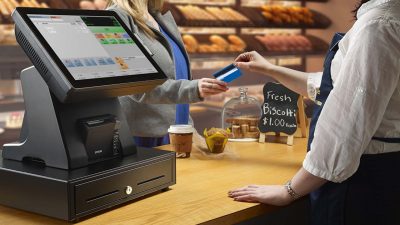Point of sale (POS) systems can transform the way a small business operates, helping them process transactions, manage inventory, and track sales data.
The maintenance fees associated with a POS system can quickly add up, costing more than may have initially met the eye. To avoid surprise fees, making the best choice for your business and managing the maintenance over time helps to ensure you’re getting the best value from your POS system.
In this article, we discuss the types of costs you are likely to encounter when implementing a POS system, how to manage these, and what to keep an eye out for as time goes on.
Costs Associated With POS Maintenance

There are various costs that tend to be associated with the maintenance of POS systems. By having an idea of the different components, your small business can account for these and implement them into your budgeting.
- Hardware
The initial purchase of a POS system will come with the cost of the necessary hardware, such as the POS terminal, scanners, and printers where needed. For restaurants, there will be the addition of specific restaurant POS costs incurred from the extra hardware, such as ordering systems and kitchen displays. - Software
When implementing a POS system, things like security, compliance, and integration software need to be considered. These could be initial one-off costs or ongoing monthly subscriptions. - Technical support and training
Once a new system has been introduced, staff will need training on how to use it. Ongoing assistance is also needed, requiring access to customer support in case issues arise, whether handled internally or through tech support outsourcing. - Payment processing
Every payment that is made through a POS system will incur a fee. Although this varies depending on payment providers, generally this will be between 1.5% and 2.5% of the purchase amount.
Managing POS Maintenance Costs

Choosing the right POS system for your business can have a huge impact on not only costs, but the smooth running of your business. Research into the different systems will show if a system has a good balance of functionality and cost. Make sure to keep in mind the necessary features for the nature of your business, whether this be accepted payment types, expected transaction volume, or any other unique business needs.
Some of the most popular POS systems are Epos, Toast, and Shopify, providing a good solution across many industries. For small businesses, opting for complex systems may be difficult to adapt to and mean higher ongoing costs.
Many businesses are opting for cloud-based POS solutions nowadays. The cloud POS market is projected to grow to over $13 billion by 2028, a huge jump from the $13.24 billion it was at in 2020. This is due to the benefits of remote access, allowing businesses to avoid the initial hardware costs and be able to easily install ongoing updates since the system is managed centrally from the cloud.
One of the main considerations to make when choosing a provider is the payment processing fees. For small businesses, these fees can quickly add up, so finding a processor that offers competitive rates can make a big difference to profit margins. Since the market is so competitive, it’s worth noting that many processors are open to negotiation if you have a strong transaction volume or are willing to agree to a long-term contract.
Keeping An Eye Out For Hidden Fees
Although the immediate fees of a POS system are clear, it’s always important to take into account those hidden fees which may pop up along the way. Even if a provider is offering temptingly small upfront fees, there is a chance that these will be balanced out by hidden charges that can quickly add up.
Be sure to read the small print to get an understanding of any other fees which you are likely to be handed with, weighing up whether the provider is still as tempting as it initially appeared.
Setup fees are a prime example of hidden fees, being charged as a one-off cost when the provider installs the system and the software/hardware that comes with it. A training fee may also be added if you require a member of their team to show you how the new system works.
Another hidden cost is payment processing fees. Lots of POS systems charge between 1.5% and 2.5% for every transaction that is made, quickly adding up and becoming a significant form of outgoing for small businesses. Some POS systems charge a monthly statement fee whereas others will charge per transaction.
If you are looking to switch providers, one key thing to be aware of is that cancellation fees can be a nasty surprise. These can vary by provider, but often if initial costs are low, this can mean tying yourself into an ongoing contract without realizing.
How Can Your POS Save You Money?
If you choose the best POS system for your business needs, it can help keep your ongoing costs down. Being especially valuable in small businesses where every penny counts, here are some of the ways in which a POS system can help you save money:
- Manage inventory
By keeping track of your stock levels, the POS system will notify you every time you need to make an order. By eradicating the need for manual stock checks, not only can the manpower be used elsewhere, but the risk of human error is lessened. This process also ensures you are not ordering too much stock that’ll result in waste, accurately tracking inventory to ensure you always have a sufficient supply. - Maximize staff efficiency
A POS system can ensure a smoother flow among your employees. By automating a lot of the ongoing processes, staff can focus on customer service to provide a better experience and minimize wait times. The system can also monitor metrics such as sales and speed per employee, helping identify top performers and those who may require extra support. - Improved insights
The data collected by a POS system can be invaluable to a small business if used well. It collects information on buyer behavior, transaction volume, and demand–offering valuable insight into the success of your business offering. This information should be used to inform marketing strategies and improve product offerings, growing the business by tailoring it to the wants and needs of the customer. - Reduce errors
Let’s face it, errors are inevitable! However, a POS system can help automate everyday processes to provide a more accurate and efficient service. By centrally managing all pricing, promotions can be added and modifications can be made without all employees having to memorize the current offers. The automated sales data also eliminates the need for cashing up at the end of each day, minimizing the chance of mistakes being made.
By really harnessing the power of your POS system, the investment can soon pay off as your daily operations become more streamlined and modernized. This is why picking a system that is tailored to your business needs is so important, introducing features which can transform the way you work.
Keeping Your POS System Affordable Over Time
Once a POS system has been chosen and implemented, keeping ongoing costs manageable will ensure that there are no nasty surprises down the road.
Preventive maintenance should be regularly undertaken to ensure that the POS system remains effective, minimizing the likelihood of costly downtime. For systems with physical hardware, this will mean regularly cleaning the equipment, inspecting it for any signs of deterioration, and contacting the manufacturer if you believe there is a fault. For software, keeping on top of updates will ensure you are utilizing the best version–many cloud systems can be set to automatically install updates.
As well as reviewing the system itself, keep an eye on how the system is being used by staff, looking out for any patterns or areas in which training might be needed. Since a POS system is used to streamline processes, save time, and improve the customer experience, making sure it is being used correctly by employees ensures the investment is worthwhile.
Sales statistics also provide valuable insights, tracking inventory and showing data on sales performance. A study has shown that 50% of small businesses claim that the analytics and reporting in their POS system are integral to their operations. By regularly analyzing the data available, informed decisions can be made regarding inventory and marketing, identifying sales trends that may be a huge contributor to buyer behavior.
The Summary
A good POS system has the potential to transform the way a small business is run, so choosing the right POS system and staying on top of maintenance can help maximize effectiveness and keep costs to a minimum.
Keeping track of the ongoing costs associated with a POS system will ensure it remains as cost-effective as it began. As business changes, it may also mean it’s time to switch systems, so keeping an eye on other options may be the trick to keeping costs down low.
Instead of letting things keep on ticking once your system has been implemented, staying proactive will ensure your POS system delivers results without bringing hefty expenses!

